<< Previous | Displaying results 5426-5450 of 6769 for "" | Next >>
A Dutch survivor of the Ohrdruf camp shows the camp's gallows, which the Germans used to execute prisoners, to US forces (including Generals Eisenhower, Bradley, and Patton). Germany, April 12, 1945.
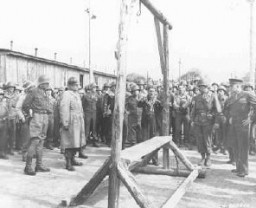
During an official tour of the newly liberated Ohrdruf concentration camp, an Austrian Jewish survivor describes to General Dwight Eisenhower and the members of his entourage the use of the gallows in the camp. Among those pictured is Jules Grad, correspondent for the US Army newspaper Stars and Stripes (on the right). Ohrdruf, Germany, April 12, 1945.
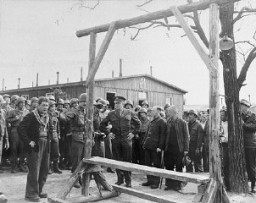
General Dwight D. Eisenhower (third from left) views the charred remains of inmates of the Ohrdruf camp. Ohrdruf, Germany, April 12, 1945.
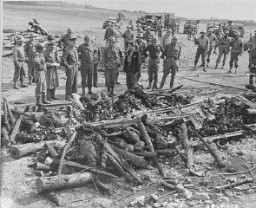
German civilians conscripted from nearby towns dig graves for some of the victims of the Ohrdruf camp. Ohrdruf, Germany, April 1945.
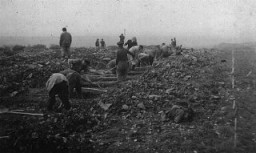
A US army officer (far right) poses with survivors of the Ohrdruf camp, a subcamp in the Buchenwald camp system. Photograph taken after the liberation of the camp. Ohrdruf, Germany, April 1945.

A watchtower and barracks at the Ohrdruf subcamp of the Buchenwald concentration camp. This photograph was taken after the US 4th Armored Division liberated the camp. Ohrdruf, Germany, June 1945.
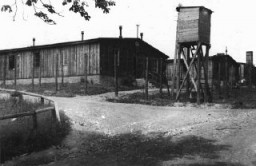
While touring the newly liberated Ohrdruf camp, General Dwight Eisenhower and other high ranking US Army officers view the bodies of prisoners who were killed during the evacuation of Ohrdruf. Ohrdruf, Germany, April 12, 1945.
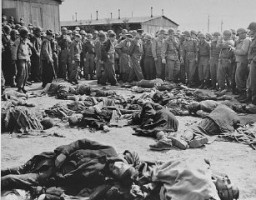
The bodies of former prisoners are laid out in rows in preparation for burial in the Ohrdruf concentration camp. Ohrdruf, Germany, April 1945.
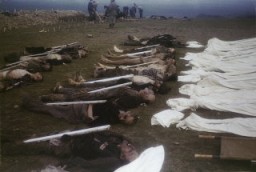
View of a mass grave in the Ohrdruf concentration camp from which 2,000 corpses were removed for proper burial. Ohrdruf, Germany, between April 20 and 25, 1945.
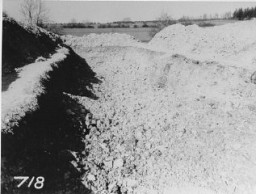
US soldiers view the bodies of prisoners found in the newly liberated Ohrdruf concentration camp. Ohrdruf, Germany, April 6, 1945.
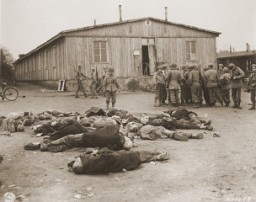
Insignia of the 1st Infantry Division. The 1st Infantry Division's nickname, the "Big Red One," originated from the division's insignia, a large red number "1" on a khaki field. This nickname was adopted during World War I, when the 1st was the first American division to arrive in France.
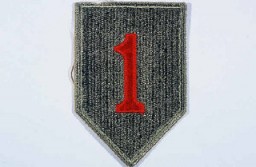
Insignia of the 2nd Infantry Division. The nickname of the 2nd Infantry Division, "Indianhead," was derived from its World War I insignia. This insignia was developed from an emblem a truck driver in the division had painted on his truck.
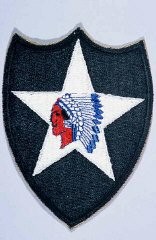
Insignia of the 4th Infantry Division. The 4th Infantry Division's nickname, the "Ivy" division, is derived from the divisional insignia developed during World War I: four ivy leaves on a diamond field, symbolizing the roman numeral "IV."
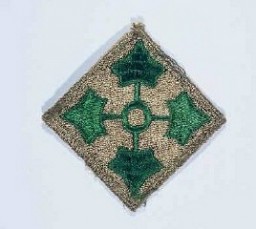
Insignia of the 4th Armored Division. The commanding general of the 4th Armored Division refused to sanction an official nickname for the 4th, believing that the division's accomplishments on the battlefield made one unnecessary. "Breakthrough" was occasionally used, apparently to highlight the division's prominent role in the breakout from the Normandy beachhead and liberation of France in 1944.
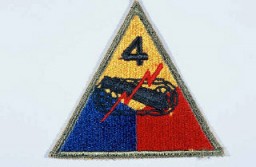
Insignia of the 6th Armored Division. "Super Sixth" became the nickname of the 6th Armored Division while the division was training in the United States, apparently to symbolize the division's spirit.
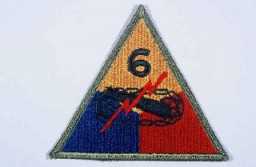
Survivors in Buchenwald just after liberation. Troops of the US 6th Armored Division entered Buchenwald on April 11, and troops of the 80th Infantry arrived on April 12. Buchenwald, Germany, photograph taken ca. April 11, 1945.
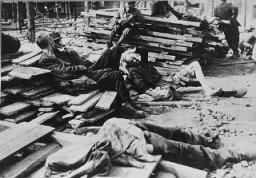
Lt. Col. J.W. Branch, Chief Surgeon of the 6th Armored Division, provides medical care to a Hungarian survivor in Penig, a subcamp of Buchenwald. Penig, Germany, April 26, 1945.
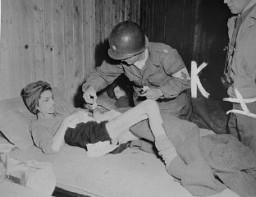
Insignia of the 14th Armored Division. Although lacking a nickname during the war, the 14th became known as the "Liberators" soon afterward to signify its accomplishments in liberating hundreds of thousands of forced and slave laborers, concentration camp prisoners, and Allied prisoners of war in 1945.
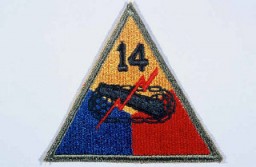
Insignia of the 84th Infantry Division. The 84th Infantry Division derives its nickname, "Railsplitter" division, from the divisional insignia, an ax splitting a rail. This design was created during World War I, when the division was known as the "Lincoln" division to represent the states that supplied soldiers for the division: Illinois, Indiana, and Kentucky. All figured prominently in the life of President Abraham Lincoln, of log-splitting legend.

Five Jewish survivors pose for a US Signal Corps photographer in front of Block 2 in the Hanover-Ahlem camp, a subcamp of Neuengamme. Hanover-Ahlem, Germany, April 11, 1945.
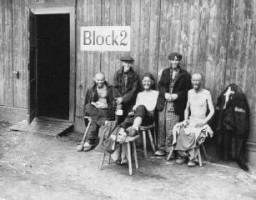
Liberator Vernon Tott (second from left) of the 84th Infantry was honored by some of the survivors he helped free from the Ahlem labor camp near Hanover, Germany. Tott's name was engraved on the Museum's Donor's Lounge wall with the inscription: "In honor of Vernon W. Tott, my liberator & hero." The ceremony in which Tott's name was unveiled came as a complete surprise to him. Washington, DC, November 2003.
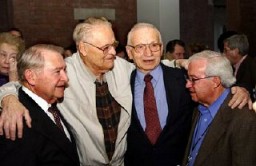
Insignia of the 86th Infantry Division. The 86th Infantry Division developed the blackhawk as its insignia during World War I, to honor the Native American warrior of that name who fought the US Army in Illinois and Wisconsin during the early nineteenth century. The nickname "The Blackhawks" or "Blackhawk" division is derived from the insignia.
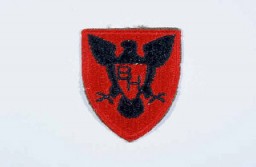
Insignia of the 89th Infantry Division. The 89th Infantry Division's nickname, the "Rolling W," is based on the division's insignia. Created during World War I, this insignia utilized a letter "M" inside a wheel. When the wheel turns, the "M" becomes a "W." The letters "MW" signify the mid-west origin of the troops who formed the 89th during World War I. The division was also known as the "Middle West" division, another variation on its origin.
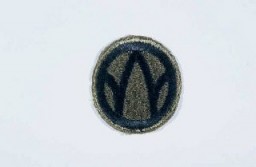
Insignia of the 90th Infantry Division. Called the "Tough Ombres," the 90th Infantry Division was raised from draftees from the states of Texas and Oklahoma during World War I. The divisional insignia incorporates the letters "T" and "O" to symbolize both states. These letters later yielded the nickname "Tough Ombres," symbolizing the esprit de corps of the unit. The 90th was also sometimes called the "Alamo" division during World War II.
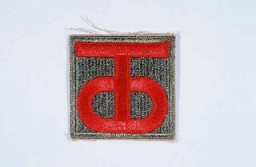
Insignia of the 11th Armored Division. "Thunderbolt" is a nickname adopted by the 11th Armored Division during its rapid march in December 1944 to reinforce US troops defending against the German military offensive in the Ardennes Forest.
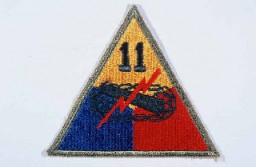
We would like to thank Crown Family Philanthropies, Abe and Ida Cooper Foundation, the Claims Conference, EVZ, and BMF for supporting the ongoing work to create content and resources for the Holocaust Encyclopedia. View the list of donor acknowledgement.